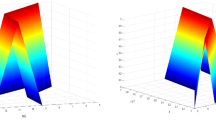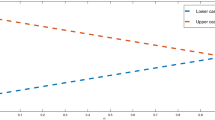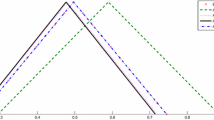Abstract
In this paper, a new approach based on a generalized fuzzy hyperbolic model is used for the numerical solution of variable-order fractional differential algebraic equations. The fractional derivative is described in the Atangana–Baleanu sense that is a new derivative with fractional order based on the generalized Mittag–Leffler function. First, by using fuzzy solutions with adjustable parameters, the variable-order fractional differential algebraic equations are reduced to a problem consisting of solving a system of algebraic equations. For adjusting the parameters of fuzzy solutions, an unconstrained optimization problem is then considered. A learning algorithm is also presented for solving the unconstrained optimization problem. Finally, some numerical examples are given to verify the efficiency and accuracy of the proposed approach.











Similar content being viewed by others
References
Atangana A, Alqahtani RT (2016) Stability analysis of nonlinear thin viscous fluid sheet flow equation with local fractional variable-order derivative. J Comput Theor Nanosci 13:2710–17
Bazaraa MS, Sherali HD, Shetty CM (2006) Nonlinear programming: theory and algorithms, 3rd edn. Wiley, Hoboken
Bendtsen C, Thomsen PG (1999) Numerical solution of differential algebraic equations, technical report, Department of Mathematical Modelling, Technical University of Denmark, Lyngby, Denmark
Boulkaibet I, Belarbi K, Bououden S, Marwala T, Chadli M (2017) A new T–S fuzzy model predictive control for nonlinear processes. Expert Syst Appl 88:132–151
Buckley JJ (1992) Universal fuzzy controllers. Automatica 28:1245–1248
Cao J, Qiu Y, Song G (2017) A compact finite difference scheme for variable order subdiffusion equation. Commun Nonlinear Sci Numer Simul 48:140–149
Chen YY, Chang YT, Chen BS (2009) Fuzzy solutions to partial differential equations: adaptive approach. IEEE Trans Fuzzy Syst 17(1):116–127
Chen Y-M, Wei Y-Q, Liu D-Y, Yu H (2015) Numerical solution for a class of nonlinear variable order fractional differential equations with Legendre wavelets. Appl Math Lett 46:83–88
Coronel-Escamilla A, Gómez-Aguilar JF, Torres L, Escobar-Jiménez RF (2018) A numerical solution for a variable-order reaction–diffusion model by using fractional derivatives with non-local and non-singular kernel. Phys A 491:406–24
Cui Y, Zhang HG, Wang Y, Gao W (2016) Adaptive control for a class of uncertain strict-feedback nonlinear systems based on a generalized fuzzy hyperbolic model. Fuzzy Sets Syst 302:52–64
Dang QV et al (2017) Robust stabilizing controller design for Takagi–Sugeno fuzzy descriptor systems under state constraints and actuator satu-ration. Fuzzy Sets Syst 329:77–90
Deng W, Zhao H, Zou L, Li G, Yang X, Wu D (2017a) A novel collaborative optimization algorithm in solving complex optimization problems. Soft Comput 21:4387–4398
Deng W, Zhao H, Yang X, Xiong J, Sun M, Li B (2017b) Study on an improved adaptive PSO algorithm for solving multi-objective gate assignment. Appl Soft Comput 59:288–302
Deng W, Xu J, Zhao H (2019) An improved ant colony optimization algorithm based on hybrid strategies for scheduling problem. IEEE Access 7:20281–20292
Dong J, Fu Y (2017) A design method for T–S fuzzy systems with partly immeasurable premise variables subject to actuator saturation. Neurocomputing 225:164–173
Fu Z, Chen W, Ling L (2015) Method of approximate particular solutions for constant- and variable-order fractional diffusion models. Eng Anal Bound Elem 57:37–46
Ghanbari B, Gómez-Aguilar JF (2018) Modeling the dynamics of nutrient–phytoplankton–zooplankton system with variable-order fractional derivatives. Chaos, Solitons Fractals 116:114–120
Ghanbari F, Ghanbari K, Mokhtary P (2018) Generalized Jacobi–Galerkin method for nonlinear fractional differential algebraic equations. Comput Appl Math 37(4):5456–5475
Ghomanjani F (2017) A new approach for solving fractional differential–algebraic equations. J Taibah Univ Sci 11:1158–1164
Gómez-Aguilar JF (2018) Analytical and numerical solutions of a nonlinear alcoholism model via variable-order fractional differential equations. Phys A 494:52–75
Jia Y, Xu M, Lin Y (2017) A numerical solution for variable order fractional functional differential equation. Appl Math Lett 64:125–130
Karabacak M, Celik E (2013) The numerical solution of fractional differential-algebraic equations (FDAEs). New Trends Math Sci 1(2):1–6
Kosko B (1994) Fuzzy systems as universal approximators. IEEE Trans Comput 43(11):1329–1333
Lee KY, El-Sharkawi MA (2008) Modern heuristic optimization techniques: theory and applications to power systems. Wiley, Hoboken
Li X, Wu B (2017) A new reproducing kernel method for variable order fractional boundary value problems for functional differential equations. J Comput Appl Math 311:387–393
Li X, Li H, Wu B (2017) A new numerical method for variable order fractional functional differential equations. Appl Math Lett 68:80–86
Liu H, Fu Y, Li B (2017) Discrete waveform relaxation method for linear fractional delay differential-algebraic equations. Discrete Dyn Nat Soc 6306570:9 pages
Liu S, Guo Z, Zhang HG (2008) Fuzzy hyperbolic neural network model and its application in H1 filter design, In: Sun F et al (eds) Proceedings of the 5th international symposium on neural networks: advances in neural networks, part I, LNCS 5263, Springer, Berlin, 2008, pp 222–230
Mei W, Bullo F (2017) Lasalle invariance principle for discrete-time dynamical systems: a concise and self-contained tutorial. arXiv preprint arXiv:1710.03710
Miller KS, Ross B (1993) An introduction to the fractional calculus and fractional differential equations. Wiley, New York
Mirzajani S, PourmahmoodAghababa M, Heydari A (2019) Adaptive T–S fuzzy control design for fractional-order systems withparametric uncertainty and input constraint. Fuzzy Sets Syst 365(15):22–39
Muthukumar P, Balasubramaniam P, Ratnavelu K (2016) T–S fuzzy predictive control for fractional order dynamical systems and its applications. Nonlinear Dyn 86(2):751–763
Nocedal J, Wright S (2006) Numerical Optimization, second edn. Springer- Verlag, Berlin, NewYork
Pakdaman M, Effati S (2016) Approximating the solution of optimal control problems by fuzzy systems. Neural Process Lett 43(3):667–686
Pham VT, Vaidyanathan S, Volos C, Kapitaniak T (2018) Nonlinear dynamical systems with self-excited and hidden attractors. Springer, Berlin
Sh DM, Hassani H (2017) An optimization method based on the generalized polynomials for nonlinear variable-order time fractional diffusion-wave equation. Nonlinear Dyn 88:1587–1598
Shen S, Liu F, Anh V, Turner I, Chen J (2013) A characteristic difference method for the variable-order fractional advection–diffusion equation. J Appl Math Comput 42:371–386
Shen H, Su L, Park JH (2017) Reliable mixed/passive control for T–S fuzzy delayed systems based on a semi-Markov jump model approach. Fuzzy Sets Syst 314:79–98
Shiri B, Baleanu D (2019) System of fractional differential algebraic equations with applications. Chaos Solitons Fractals 120:203–212
Solís-Pérez JE, Gómez-Aguilar JF, Atangana A (2018) Novel numerical method for solving variable-order fractional differential equations with power, exponential and Mittag–Leffler laws. Chaos Solitons Fractals 114:175–185
Sun H, Chen W, Li CH, Chen Y (2012) Finite difference schemes for variable-order time fractional diffusion equation. Int J Bifurc Chaos 22:1250085
Sun Q, Wang Y, Yang J, Qiu Y, Zhang H (2014) Chaotic dynamics in smart grid and suppression scheme via generalized fuzzy hyperbolic model. Math Probl Eng 2014, Article ID 761271, 7 pages
Sun H, Zhang Y, Baleanu D, Chen W, Chen Y (2018) A new collection of real world applications of fractional calculus in science and engineering. Commun Nonlinear Sci Numer Simul 64:213–231
Takagi T, Sugeno M (1985) Fuzzy identification of systems and its applications to modeling and control. IEEE Trans Syst Man Cybern 15(1):116–132
Wang LX (1992) Fuzzy systems are universal approximators. In: Proceedings 1EEE international conference on fuzzy systems (San Diego), pp 1163–1170
Wang L, Chen N (2014) The predictor-corrector solution for fractional order differential algebraic equation. In: CFDA’14 international conference on fractional differentiation and its applications
Wang SH, Jhu WL, Yung CF, Wang PF (2011) Numerical solutions of differential algebraic equations and its applications in solving TPPC problems. J Mar Sci Technol 19:76–88
Wu ZG, Dong SH, Shi P, Su H, Huang T, Lu R (2017) Fuzzy-model-based nonfragile guaranteed cost control of nonlinear markov jump systems. IEEE Trans Syst Man Cybern Syst 47(8):1–10
Xu T, Lu S, Chen W, Chen H (2018) Finite difference scheme for multi-term variable-order fractional diffusion equation. Adv Differ Equ 103:1–13
Yaghoobi S, Moghaddam BP, Ivaz K (2017) An efficient cubic spline approximation for variable-order fractional differential equations with time delay. Nonlinear Dyn 87:815–826
Yang XJ (2017) Fractional derivatives of constant and variable orders applied to anomalous relaxation models in heat-transfer problems. Therm Sci 21:1161–1171
Ying H (1994) Sufficient conditions on general fuzzy systems as function approximators. Automatica 30:521–525
Zak SH (2003) Systems and control. Oxford University Press, Oxford
Zeng XJ, Singh MG (1995) Approximation theory of fuzzy systems-MIMO case. IEEE Trans Fuzzy Syst 3(2):219–235
Zhang X-S (2000) Neural networks in optimization. Kluwer Academic Publishers, Dordrecht
Zhang HG, Yongbing Q (2001) Modeling, identification, and control of a class of nonlinear systems. IEEE Trans Fuzzy Syst 9(2):349–354
Zhang M, Zhang H (2005) Modeling and control based on generalized fuzzy hyperbolic model. In: American control conference
Zhang M, Zhang H (2006) Robust adaptive fuzzy control scheme for nonlinear system with uncertainty. J Control Theory Appl 4(2):209–216
Zhang HG, Wang Z, Liu D (2003) Chaotifying fuzzy hyperbolic model using adaptive inverse optimal control approach. Int J Bifurc Chaos 12:32–43
Zhang HG, Wang ZL, Li M, Quan B, Zhang MG (2004a) Generalized fuzzy hyperbolic model: a universal approximator. Acta Autom Sin 30(3):416–422
Zhang HG, Wang ZL, Li M, Quan B, Zhang MJ (2004b) Generalized fuzzy hyperbolic model: a universal approximator. Acta Autom Sin 30(3):416–422
Zhang M, Zhang H, Liu D (2004c) A generalized fuzzy hyperbolic modeling and control scheme. In: IEEE international conference on fuzzy systems
Zhang HG, Wang Z, Liu D (2005) Chaotifying fuzzy hyperbolic model using impulsive and nonlinear feedback control approaches. Int J Bifurc Chaos 15(8):2603–2610
Zhang JL, Zhang HG, Luo YH, Liang HJ (2013) Nearly optimal control scheme using adaptive dynamic programming based on generalized fuzzy hyperbolic model. Acta Autom Sin 39(2):142–148
Zhao H, Liu H, Xu J, Deng W (2019a) Performance prediction using high-order differential mathematical morphology gradient spectrum entropy and extreme learning machine. IEEE Trans Instrum Meas. https://doi.org/10.1109/TIM.2019.2948414
Zhao H, Zheng J, Xu J, Deng W (2019b) Fault diagnosis method based on principal component analysis and broad learning system. IEEE Access 7:99263–99272
Zhao H, Zheng J, Deng W, Song Y (2020) Semi-supervised broad learning system based on manifold regularization and broad network. IEEE Trans Circuits Syst I Regul Pap 67(3):983–994
Zhu Q, Azar AT (2015) Complex system modelling and control through intelligent soft computations. Springer, Berlin
Zurigat M, Momani SH, Alawneh A (2010) Analytical approximate solutions of systems of fractional algebraic differential equations by homotopy analysis method. Comput Math Appl 59:1227–1235
Acknowledgements
This study was not funded by any grant.
Author information
Authors and Affiliations
Corresponding author
Ethics declarations
Conflict of interest
The authors declare that they have no conflict of interest.
Additional information
Communicated by V. Loia.
Publisher's Note
Springer Nature remains neutral with regard to jurisdictional claims in published maps and institutional affiliations.
Rights and permissions
About this article
Cite this article
Mortezaee, M., Ghovatmand, M. & Nazemi, A. Solving variable-order fractional differential algebraic equations via generalized fuzzy hyperbolic model with application in electric circuit modeling. Soft Comput 24, 16745–16758 (2020). https://doi.org/10.1007/s00500-020-04969-7
Published:
Issue Date:
DOI: https://doi.org/10.1007/s00500-020-04969-7




